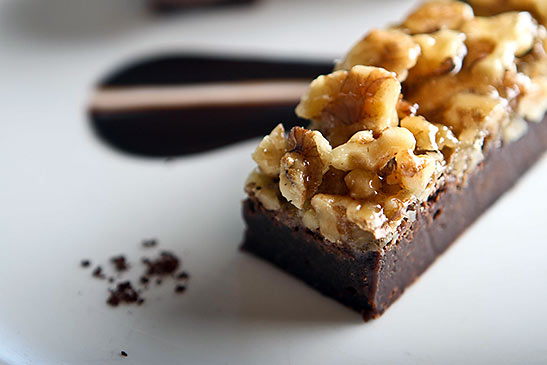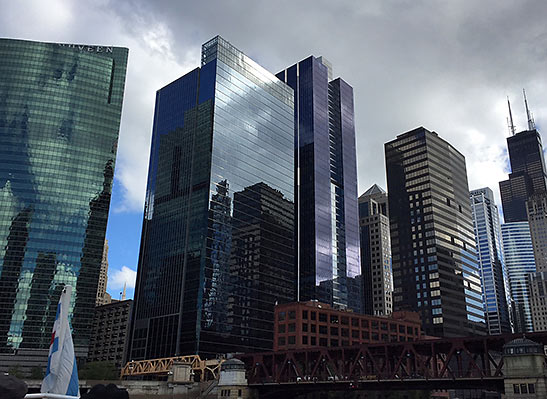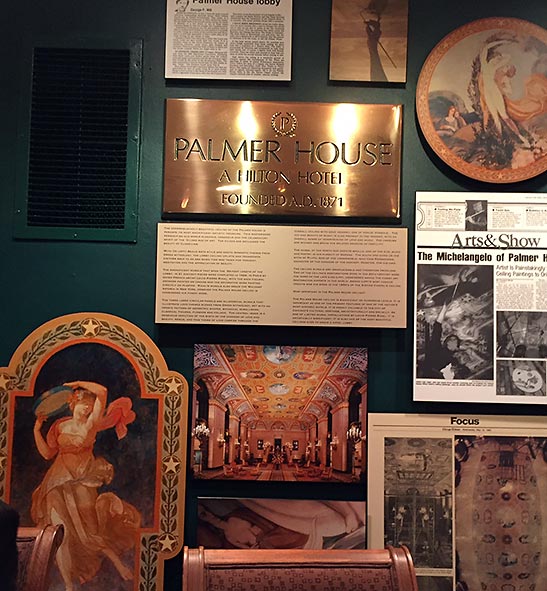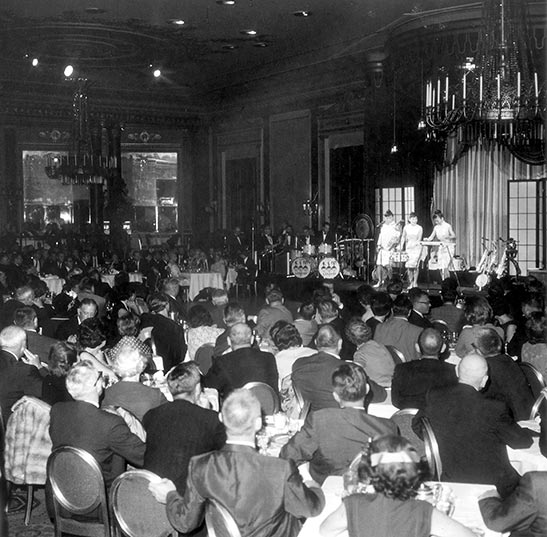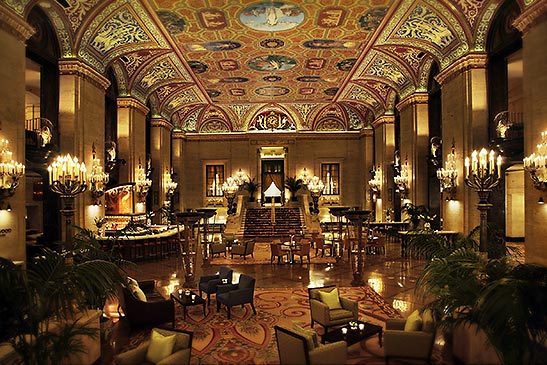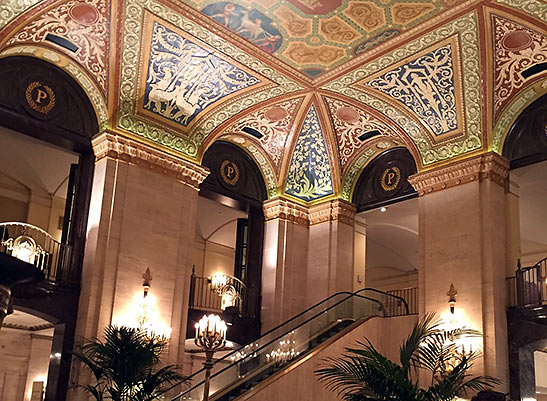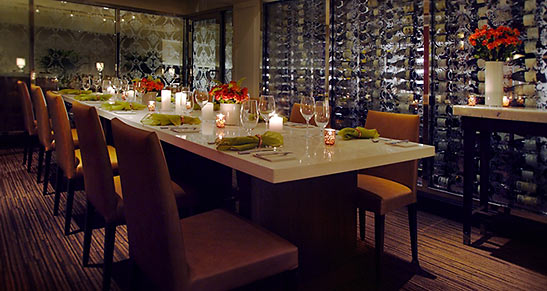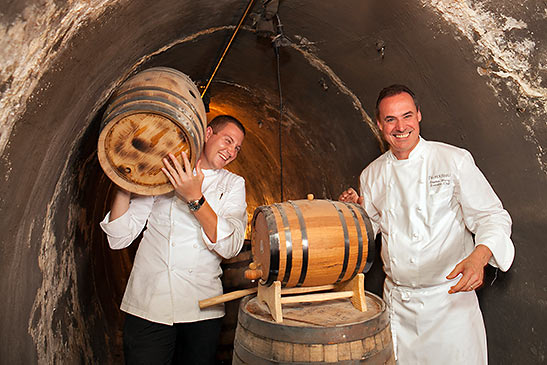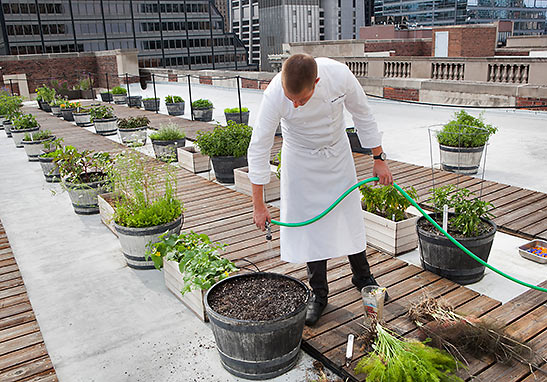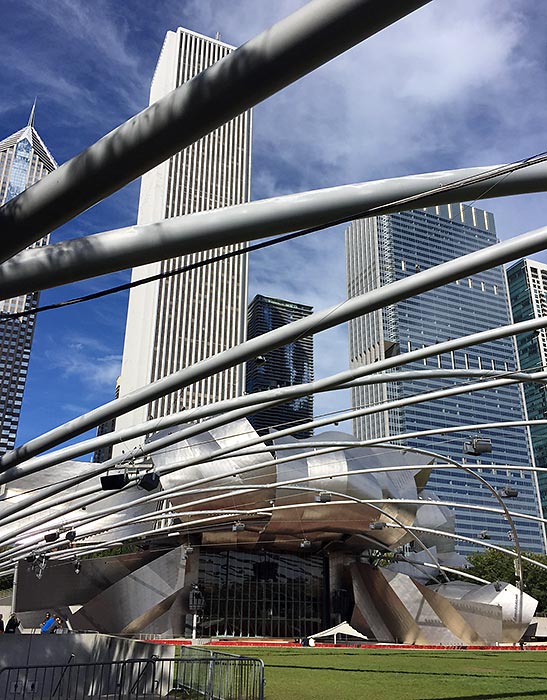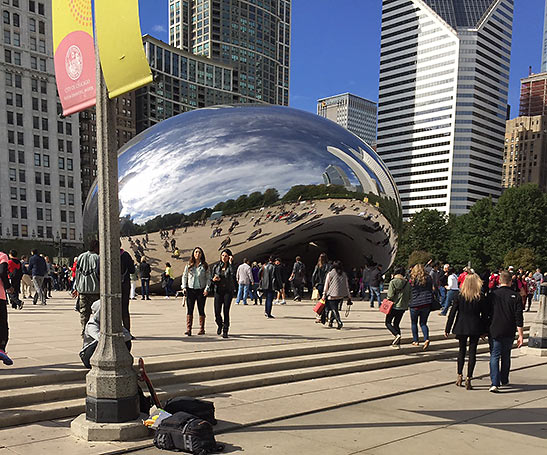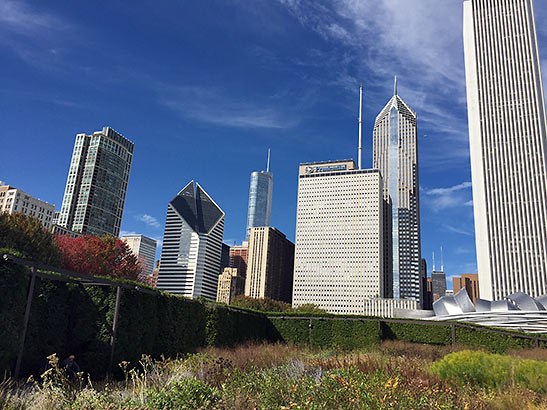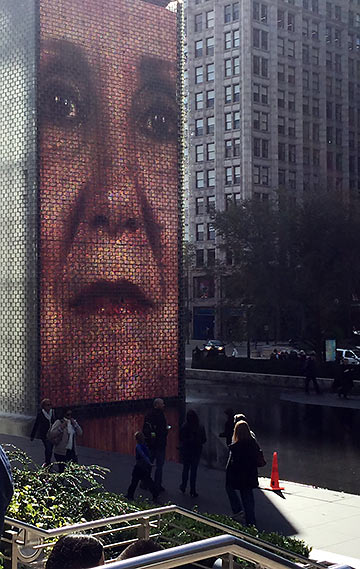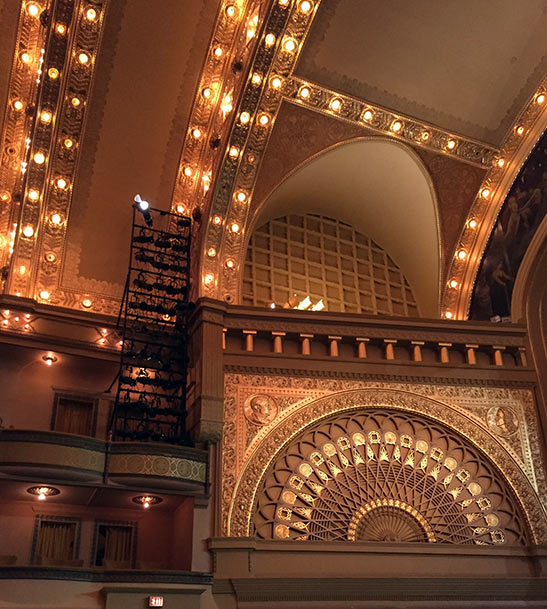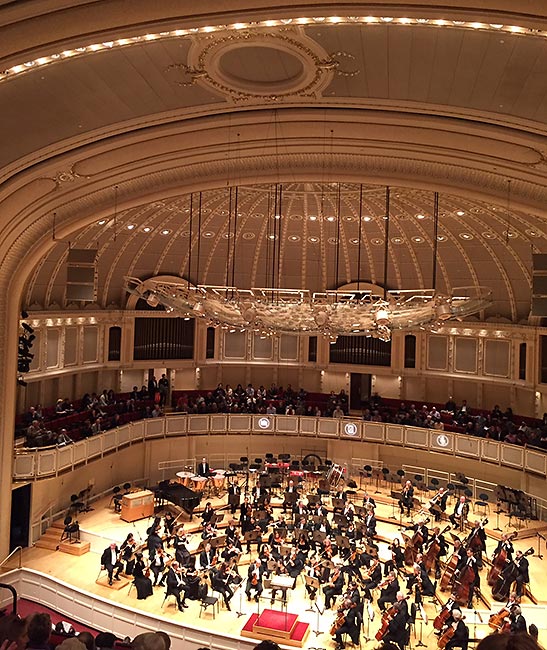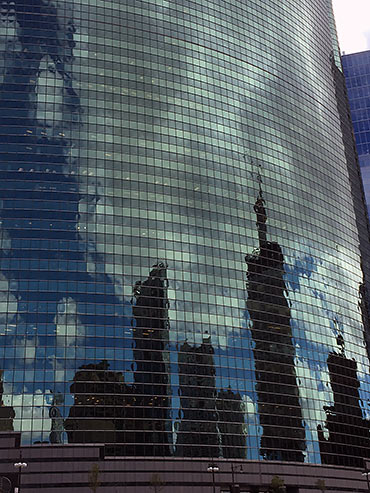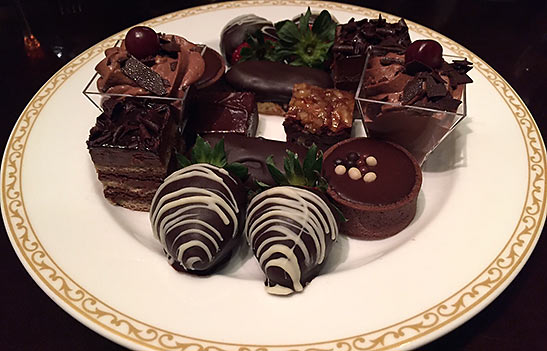 |
 |
|
 |

|
Palmer House:
The Past, the Present... and Brownies! Story by Ruth J. Katz "Bring home some nice, fresh rolls," intoned my neighbor, as we alighted from the elevator and parted ways in the lobby of our building – I, with my suitcase, heading to the airport, and she, with her toddler, heading to the playground. "Rolls?" I queried quizzically. "Yes," she repeated, "You're going to Palmer House, so bring home some rolls, those real-deal rolls." "Oh, no," I chuckled, gently correcting her. "Wrong hotel, wrong city, wrong staple!" Yes, it's true that the Parker House roll was created at the famed Parker House in Boston, but the Palmer House in Chicago's Loop area, my destination, is the originator of something far better – the brownie! Keep the rolls, and pass the chocolate.
My friend's muddled misconception may not necessarily be the first time anyone has jumbled up the two hotels and their signature foodstuffs, but it's certainly not the only occasion people have attributed to Chicago a few anecdotal sidebars to history of questionable origins: To wit, the "Windy City" is not thusly dubbed because of the gusts off Lake Michigan, but rather, the referenced airstream is an allusion to the long-winded, filibustering politicians of yore. And the bit about Mrs. O'Leary's cow's kicking over a lantern and igniting the Great Fire in 1871 is either apocrypha or gospel, depending on whose account you're hearing. But both Mrs. O'Leary and the recalcitrant bovine were exonerated officially as the perpetrators of the flames by the city's Committee on Police and Fire in 1977, after an hour's worth of testimony. As for Chicago's being the Second City, well, at one time, she was, based on population alone, but now she has to play third fiddle to the Left Coast's LaLa Land and Gotham.
What is true, however, is that if you go to Chicago's Palmer House, a Hilton Hotel, you will have not only brownies at the gracious, palatial (1,641 rooms!) property, but you will also be treated royally by the cosseting staff and you will enjoy the hotel's proximity to so many of Chicago's attractions. Palmer House is steeped in history, and while the walls don't literally speak, they do tell a tale:
Walk down the hallways and soak up at the evocative black-and-white photographs hung throughout the corridors – come face to face with portraits of legendary performers who graced the hotel's equally celebrated Empire Room, which was, in the day, a high-end supper club, similar to El Morocco in New York or the Persian Room at the heralded Fairmont Hotel in San Francisco. Between 1933 and 1976, the roster of artists included, among the many, Carol Channing, Ethel Merman, Louis Armstrong, Tony Bennett, Jimmy Durante, Liberace, Judy Garland, Frank Sinatra, and Maurice Chevalier. In other words, anybody who was anybody in the world of showbiz came to the Palmer House to perform.
But the Palmer House has so much more history than that. Born in Albany County, New York, in 1823, Potter Palmer, the hotel's powerhouse builder and namesake, had no formal education, but was a business whiz. Not content to be a gentleman farmer in the East, he headed westward and decided Chicago felt just about right, and not parenthetically, the fair city presented lots of opportunities. He was highly successful with a dry goods shop and some real estate ventures. By the time he was barely 40, he was assuredly a catch, but the woman he wanted to reel him in, Bertha Honoré, was 26 years his junior, a mere 13 when he met her! Not to be daunted, Palmer waited until Bertha was 21 and then the two were wed. As a wedding gift, Palmer built an imposing hotel, the first Palmer House, which tragically, 13 days after it was completed in 1871, and just before he and Bertha were to move in, was decimated along with much of Chicago, by the Great Fire. $3.5 million – the cost of Palmer's hotel-went up in the scorching blaze, along with 73 miles of roads, 17,5000 structures, 2,000 miles of sidewalk. Ultimately, 90,000 souls were left homeless. Courageously, Palmer borrowed $1.7 million – the largest private loan ever made – and built the second Palmer House, and in 1875, he swung open the doors of his majestic inn. This time around, however, Palmer had instructed architect John M. Van Osdel to make the edifice fireproof and it was advertised as such, the world's only fire-proof hotel. Built across the street from the first Palmer House, it remained the jewel in Palmer's portfolio, until the preset-day Palmer House was constructed; by the roaring 20s, Chicago was bustling and the Palmer estate (Potter had passed away in 1902) felt the city could support a much larger property, and the seven-story second Palmer House was replaced by a 25-story "tower," the current hotel. The lobby alone speaks of the hotel's grandeur. The ceiling of the main salon, nearly 40 feet high, is awash with 21 colorfully painted art works, accented with and interspersed by Wedgewood blue and russet-umber bas relief decorations.
The building boasted a "vertical steam railroad" which led to Otis' invention of the elevator. The hotel also initiated the use of Bell's invention – the telephone! And it also put into use Edison's brainchild, the light bulb! Worth a footnote: Bertha amassed one of the finest collections of Impressionist art and some of her collection was periodically on display in the hotel. Today, guests can enjoy fine dining in the Lockwood restaurant; and for private feasting, Lockwood has a discreet dining room where sumptuously prepared meals are served.
A recent, mouth-watering, five-course repast included sea scallops with uni toast, yuzu foam, and kelette kimchi; duck breast, plum sauce, bao bun, shaved Brussel salad, and duck confit; and kobe and veal cheek, parsley root puree, and roasted sweet potato.
Of course, there are the usual health club and fitness center facilities (you will need them after a meal at Lockwood!), and can even inquire about the subterranean (65 feet below street level), caves where the Dublin-born, executive chef, Stephen Henry, has barrels of maple syrup "brewing," infused with a variety of bourbons and Scotch whiskeys.
On the roof is a garden where Henry and his staff nurture herbs and fresh produce – strawberries, okra, cantaloupe, amaranth, nasturtium, Gretel eggplants, for example – along with an apiary for a clan of very busy, honey-making bees, tended by a keeper; worth noting, their hive-home is a fastidiously built-to-scale replica of the hotel!
Bees are not the only creatures at Palmer House – pets are also welcome here. Annually there is a doggie fundraising event, benefiting an animal-related charity or organization, and a highlight of the Chicago canine calendar!
One of the hotel's pluses is its location, a mere 1,800 feet, as the pedestrian walks, from the Art Institute of Chicago. Bertha's outstanding Impressionist collection resides there now, so when you go, pay homage to her. She was a remarkable woman, just as Potter was an extraordinary man... and as a Trivial Pursuit aside, it is worth noting that in his will, Potter bequeathed an astonishing million bucks to Bertha's next husband!! Of course, she never remarried; Potter was just too charismatic and magnetic a personality, too larger-than-life, even in death, for Bertha to have ever mated again. But, back to sightseeing: The hotel is also a hop, skip, and jump from the wondrous Millennium Park, opened in 2004 and occupying some 24 acres.
The park features the Jay Pritzker Pavilion, Cloud Gate, the Crown Fountain, the Lurie Garden, among the attractions. The Cloud Gate, popularly known as "The Bean," is a high-gloss, amoebic and amorphously shaped stainless steel sculpture that invites selfies. One of the first public art works by Anish Kapoor, The Bean's surface reflects and distorts the scenery, entertainingly.
Also celebrating its 125th season is the Chicago Symphony Orchestra and its home, Symphony Center, is just around the corner from the hotel. I had the serendipitous fortune to be there during the orchestra's season, so I was able to snag a ticket, to enjoy a superb program, conducted by Maestro Ricardo Muti; given how rich and diverse the orchestra's repertoire is, you will score no matter what selections you hear.
If Chicago architecture is of interest, then a must is the Chicago Architecture Foundation's river cruise, but obviously, only if you are visiting in the warmer weather. The tour offers a bird's-eye view of the city from quite another angle and it is an extremely enlightening journey. If you know nothing about architecture, you'll certainly learn to recognize the hallmarks of Historic Revival, Post-Modernism, Art Deco, Neo-Classic, Beaux Arts, for starters: Catch a glimpse of Aqua by Studio Gang, with its undulating wave-like shell; the famed Merchandise Mart with its pyramidal towers; the AMA Plaza, Mies van der Rohe's last building; the Willis Tower (formerly the Sears Tower), noteworthy for having been the tallest building in the world for 24 years and for its bundled-tube construction; the twin towers of the 1960s' Marina City with their semi-circular balconies, giving the exterior façade the look of scalloped concrete; and 333 Wacker Drive West, with its curved, twinkling frontage, constantly reflecting the shifting panorama of the city, depending on the light and the angle. And that is the thing about Chicago: It is a city ever-changing, and thus, even if you visited last year, there is every reason to revisit. Make your hotel choice the Palmer House and hunker down with Bertha and Potter, along with a bedtime glass of warm milk... and brownies. Just for the record, Bertha had instructed her chefs, when she was the president of the Board of the Lady Managers for the 1893 Columbian Exposition World's Fair, to create something new and different to eat. The brownie was their concoction. Thereafter, the first reference to the newly christened brownie in America appears in the Sears Roebuck catalog published in Chicago in 1898. And, of course, I brought home a little shopping bag of brownies for my neighbor.
Related Articles: |
|
|
This site is designed and maintained by WYNK Marketing. Send all technical issues to: support@wynkmarketing.com

|






